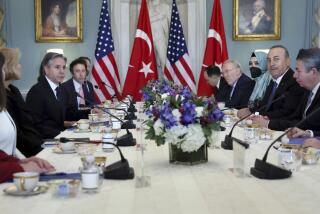Common Sense Takes Off
This is a good-news editorial about the Pentagon. About the professional military and political people of both parties in that institution and the diverse military fraternities there. It’s also good news about the private defense industry. No, really. It’s true. Keep reading because good news really can be interesting. For the first time, these defense folks--who’ve long been lambasted for bringing us the likes of the $600 ashtray--all worked together to develop plans for one efficient, massive weapons system to serve all the armed services, the Joint Strike Fighter.
Over the generations, for families with real budgets it has made sense to buy a single vehicle that’s practical for commuting, parking and navigating jammed school driveways while also providing speed, efficiency and comfort for long vacations and the roomy endurance to haul both excited Cub Scouts and teenagers mortified by nerdy cars. But all-purpose is a revolutionary thought in the defense business and among the parochial services, with their individual missions--and jealousies. Now that they’ve applied this joint approach to the largest defense contract in U.S. history, we need to praise it. (Applause.)
Recently the Pentagon announced that Lockheed Martin won the $19-billion initial contract to begin building the Joint Strike Fighter, a nimble stealth aircraft that can, with adaptations, serve the varying needs of the Navy with its carriers, the Air Force with its long missions and runways and the Marines, which need a plane to land vertically over by those bushes. It’s basically General Motors using the same chassis and engine block for Chevys, Buicks and Oldsmobiles. This common platform produces significant design, material and construction economies, reducing unit costs to about $35 million, a steep price for a Buick but pretty cheap for a sophisticated military craft.
The JSF idea began in the early 1990s with a joint political and military realization that defense and budget realities were changing and procurement policies needed to as well. The Democratic Clinton administration drove the idea, and, get this, the Republican Bush administration followed suit. Neither permitted Congress’ local demands to distract.
Boeing, the other JSF competitor, was understandably unhappy over losing what could be a $200-billion deal for perhaps 3,000 planes ultimately, plus foreign sales. But, now get this too, the Pentagon suggested that Lockheed award subcontract work to the loser to maintain two viable defense contractors and minimize local political opposition to future funding. Lockheed agreed.
We’re unsure how all this common sense and cooperation sneaked under the nation’s defense radar. But in the interests of efficiency and uniformity, we’re sending the same all-purpose, non-stealth message to each of the participants simultaneously: Good job. The new planes won’t take off for several years. But we hope the idea of such defense practicality continues to soar long and far.
More to Read
Sign up for Essential California
The most important California stories and recommendations in your inbox every morning.
You may occasionally receive promotional content from the Los Angeles Times.










